Materials that can mend themselves sound like science fiction, but they are part of an active area of polymer chemistry. Nina Notman stitches together the different strands of research
Materials that can mend themselves sound like science fiction, but they are part of an active area of polymer chemistry. Nina Notman stitches together the different strands of research
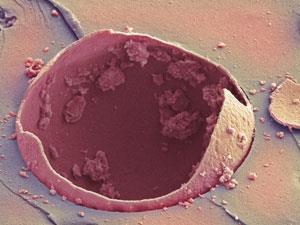
This daydream could become reality, thanks to the coatings and other polymeric materials that can heal themselves autonomously that are being developed in labs today.
All polymer materials are at risk of damage – especially in the form of scratches and tears – which can affect their structural integrity and shorten their lifespan. While repairs using patches or glues are possible, the results are often less than pleasing aesthetically and the strength of the mended material may still be compromised after mending. And in the case of a car, having a scratch removed from the paintwork can be expensive. Over the past decade or so there have been a variety of attempts in research laboratories to create materials that are able to heal themselves once damaged – with no patch, glue or other type of intervention required.
Catalyst capsules
In 2001, Scott White and colleagues at the University of Illinois, US, published the first example of such a system based on capsules containing a ‘healing agent’ embedded in a structural polymer.1 When the material cracks, the capsules are torn open and their liquid contents spill out, flowing into the crack through capillary action. Here they undergo a reaction to create a new polymer that fills the gap left by the tear. In the first generation system, the capsules contained the liquid monomer dicyclopentadiene and a Grubbs’ catalyst was embedded at numerous points in the matrix.
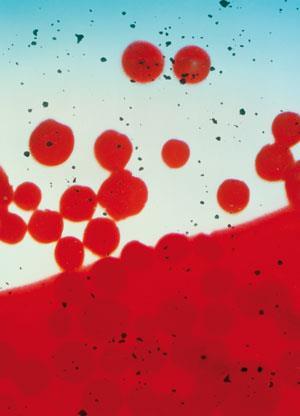
White and his team have recently steered the research towards the regeneration of electrical conductivity in damaged microelectronic polymeric components.2 If a microelectronic circuit is torn, and a conducting line broken, the system will cease conducting electricity and the component will need replacing. White’s team’s solution is to put conducting materials into capsules, which when torn open will flow into the gaps in the conductive lines, restoring conductivity.
‘We’ve put things like liquid metals, carbon nanotubes and graphene into capsules, and then shown that, if you release them, then you can restore conductivity of the metal line,’ explains team member Nancy Sottos. ‘We’ve shown that if you take a knife and slice it through a metal line in a circuit that has a light bulb on it, you see the light bulb go out. The capsules underneath the metal line release a conductive agent and restore conductivity.’
Mechanically minded
Another entirely different approach being taken by White’s team is the use of mechanophores – a mechanically sensitive unit – engineered into the backbone of the polymers. Pulling the mechanophore from both ends causes the unit to change shape, triggering the start of a healing reaction. The team has experimented with a range of different mechanophores, including one that forms a cyanoacrylate when pulled.
‘Essentially it is forming a superglue type complex when it is pulled,’ says Sottos. ‘More recently – and this is one we are really excited about – we’ve made an acid-generating mechanophore,’ she adds.3 The acid catalyses a polymerisation reaction within the material. ‘What we are doing is using force to stimulate this acid-generating mechanophore and the idea is that it will be able to cross link the polymer so that it can heal and toughen as the force is applied.’
Rint Sijbesma at Eindhoven University of Technology in the Netherlands is leading another team working on autonomous self-healing systems that are activated by the tearing of the bulk material. His approach involves the use of a latent catalyst that is activated by putting the material under stress. The catalysts consist of a metal core with two strongly bound ligands in the form of polymer chains. When one of the chains is ripped off, by scratching or tearing the material, the latent catalyst is activated. ‘Our concept was that if you apply a force to a polymer chain you would remove a ligand from the metal, and then the metal could act as a catalyst because it has free sites where it could bind substrate molecules,’ Sijbesma explains. In this system the monomer that is required to react with the activated catalyst is free in the bulk material.When one of the chains is ripped off, the latent catalyst is activated
This concept was initially proven in solution, with ultrasound used to tear the ligands from the metal,4 but has now been shown to work in the solid state. ‘We have a very recent development, that we can now perform this process not only in solution, but in the solid state in a plastic material,’ says Sijbesma. ‘That is unpublished material and we have to go through all the control experiments before we can submit a manuscript. But the results look extremely promising right now.’
One of the pluses to this approach is the fact that a latent catalyst is used, compared to the activated Grubbs’ catalyst used in White’s capsules system. Sijbesma claims that this will prolong the lifetime of the system. It does, of course, have the pitfall of the catalyst dying eventually after activation and only having a fixed supply of monomer, limiting the number of times the system can be rehealed. ‘The main limitation is diffusion in such as system, and we are looking into that right now,’ says Sijbesma. ‘In principle you can only do it for a limited number of times because once you initiate the polymerisation reaction, the activated catalyst consumes all of the monomer that is in its environment and then it dies, and cannot be activated again.’
Hydrogen help
Another potential issue with Sijbesma’s approach and indeed both of White’s approaches is that the ‘new’ polymer that fills the cracks is different to that of the main bulk of the material. This has potential problems, especially with the strength of repeatedly repaired materials. And it is something that the team led by Ludwik Leibler at the Industrial Physics and Chemistry Higher Educational Institution in Paris, France, has been able to address.
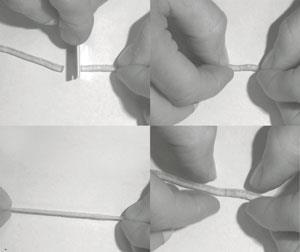
The significance of this system is that the rubber is not adhesive. There are other soft materials out there that ‘heal’ themselves, but they are all sticky by nature – like chewing gum, for example. ‘The challenge was to design something that is not an adhesive and only when you break it does it become healable,’ he says.
The lifetime of free hydrogen bonds is quite short, explains Leibler, and he was therefore surprised to find that healing can still occur if the cut ends are not pushed back together for more than a day after the initial cut. He says that his team is currently working to understand why this is. By contrast, the length of time the ends need to be held together before healing occurs is surprisingly quick: the strength was restored after 15 minutes in the first prototype materials but after just one minute in the new generation.
This system also has the added advantage of being reversible, so the healing cycle can occur an unlimited number of times.6 ‘It can be done as many times as you want,’ says Leibler. There are some perceived disadvantages to this type of system that does not require a trigger (such as tearing) to start the healing process, and one of these is the possibility of flow. ‘I am sceptical that systems that reform themselves under ambient conditions without the requirement for a trigger would be stable under load,’ says Christoph Weder, an expert in healable polymers at the University of Fribourg in Switzerland. ‘Because the bonds reform all the time, if you put the system under stress it will yield to that stress and therefore the material will flow.’ Leibler, however, claims that this is not a problem: it doesn’t flow ‘because it makes a network and this physical network is responsible for very long relaxation times. For three months it will not relax.’
Let there be light
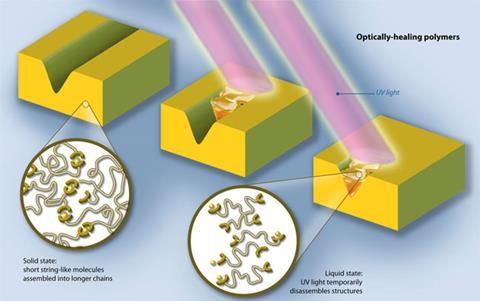
One such system is being developed by Weder and his collaborator Stuart Rowan at Case Western Reserve University in Cleveland, US. They used a supramolecular system held together by dynamic coordination bonds, rather than the weaker hydrogen bonds used in Leibler’s system. But for both approaches, the material is homogeneous; the ‘fixed’ part is made up of the same polymer as the bulk material. And the material is designed so that it can be broken and healed an unlimited number of times.
‘This material that we make is composed of small molecules that are designed to aggregate into polymeric structures,’ explains Rowan. ‘What we reported in 2011 was the use of a stimulus,7 in this case light, to depolymerise that polymer to the point that you end up back with small molecules. That reduces the viscosity of the material that allows the crack to be filled.’ When the light source is removed, the molecules re-aggregate and the material repolymerises, filling the gap and regaining its original strength.
The first generation of these materials was based on metal–ligand interactions, where the light triggers dissociation of the metal from the rubbery cross-linked phase. However, later generations of this concept have removed the need for the metal.
The importance of this work lies in the use of light to generate heat in a very localised area, rather than just using a heat gun to trigger the depolymerisation. ‘What light does is allow you to specifically target very selective parts of the material,’ says Rowan. ‘We are using a photothermal conversion process, so the material has been designed to absorb light at a specific wavelength, and that excites the molecule that in turn results in localised heating. The rest of the material stays intact, allowing you to heal the material under some kind of load,’ he explains.A lot of these approaches are complementary to each other
‘The UV light must be matched with the absorption of the supramolecular motif,’ adds Weder. ‘We use lamps that are similar to the lamps that dentists use in the mouth when they cure a dental filling.’ One possibility, says Weder, is to supply end users with light pens to allow them to heal the material once damaged.
Weder suggests his team’s proof-of-concept materials may eventually find use as both coatings and bulk materials, although he does say that further work will be required to strengthen these supramolecular systems first. ‘If you look at the supramolecular systems, you’ll find that most of the polymers are relatively soft – they are not very stiff – so making them stronger and stiffer is one direction that is a general one.’
All the systems discussed in this article are still in the proof-of-concept stage and all differ slightly in their designs and advantages and disadvantages. Rowan sees this as a positive thing, saying there is a place for multiple different systems in the market place. ‘When you are looking at these different approaches, they all have different pros and cons,’ he explains. ‘A lot of these approaches are complementary to each other.’
When the discussion turns to when we might be able to purchase these products it is clear than most of these systems are a way off yet. But the interest is definitely there to drive the ideas out of the academic lab and into the market place. ‘I know a lot of companies are very interested in this field,’ enthuses Rowan.
Nina Notman is a science writer based in Salisbury, UK
References
1 S R White et al, Nature, 2001, 409, 794 (DOI: 10.1038/35057232)
2 S A Odom et al, Adv. Mater., 2012, 24, 2578 (DOI: 10.1002/adma.201200196)
3 C E Diesendruck et al, J. Am. Chem. Soc., 2012, 134, 12446 (DOI: 10.1021/ja305645x)
4 A Piermattei, S Karthikeyan and R P Sijbesma, Nat. Chem. 2009, 1, 133 (DOI: 10.1038/nchem.167)
5 P Cordier et al, Nature, 2008, 451, 977 (DOI: 10.1038/nature06669)
6 F Maes et al, Soft Matter, 2012, 8, 1681 (DOI: 10.1039/c2sm06715c)
7 M Burnworth et al, Nature, 2011, 472, 334 (DOI: 10.1038/nature09963)
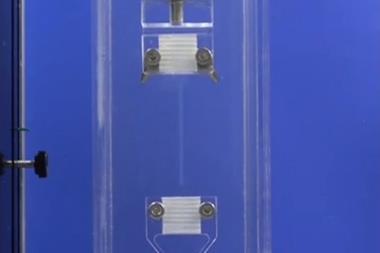











No comments yet